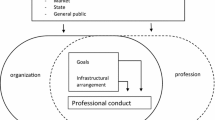Abstract
This study examines society's choice of inputs for the creation of trust in professional services. Professional codes and their enforcement are only one possible input that society has at its disposal for the production of this trust. Other inputs include civil and criminal codes. If society is modeled as a multi-input “firm,” then it will tend to use less of any input as that input grows less productive or more costly. To identify factors that might impact society's future use of professional self-regulation as a trust-producing input, the productivities and costs of enforcing professional codes are modeled.
The effectiveness of professional enforcement is seen to have its origin in the losses members face if they leave the profession. These “exit costs” are analyzed in detail. Other factors affecting professional enforcement are also evaluated.
A mathematical model of society's choice problem, contingent on exit costs and other factors, permits formal derivation of several results. Among these are the ideas that monopoly rents and specificity of skills are important in creating the conditions that make professional enforcement possible. As these deteriorate, society's reliance on professional enforcement will decline, and its dependence on courts will rise.
Similar content being viewed by others
References
Abbott, A.D. (1988).The system of professions. Chicago, IL: University of Chicago Press.
Akerlof, G.A. and Yellen, J.L. (Eds.). (1986).Efficiency wage models of the labor market. Cambridge, England: Cambridge University Press.
Aranya, N. and Ferris, K. (1984). A reexamination of accountants' organizational-professional conflict.Accounting Review 59 (January): 1–15.
Aranya, N., Pollock, J. and Amerinc, J. (1981). An examination of professional commitment in public accounting.Accounting, Organizations, and Society 6(4): 271–280.
Becker, G.S. (1968). Crime and punishment: An economic approach.Journal of Political Economy 76(2) (March/April): 169–207.
Becker, G.S. (1983). A theory of competition among pressure groups for influence.Quarterly Journal of Economics 98(3) (August): 371–400.
Becker, G.S. and Stigler, G.J. (1974). Law enforcement, malfeasance, and compensation of enforcers.Journal of Legal Studies 3(1) (Spring): 1–18.
Freidson, E. (1975).Doctoring together: A study of professional social control. New York: Elsevier.
Friedman, M. (1962).Capitalism and freedom. Chicago, IL: University of Chicago Press.
Gordon, R.W. (1985). Macaulay, Macneil, and the discovery of solidarity and power in contract law.Wisconsin Law Review 1985(3): 565–579.
Harrell, A., Chewning, E. and Taylor, M. (1986). Organizational-professional conflict and the job satisfaction and turnover intentions of internal auditors.Auditing: A Journal of Theory and Practice 5 (Spring): 109–121.
Hechter, m. (1987).Principles of group solidarity. Berkeley: University of California Press.
Hirschman, A.O. (1970).Exit, voice, and loyalty. Cambridge: Harvard University Press.
Kanter, R.M. (1972).Commitment and community: Communes and utopias in sociological perspective. Cambridge: Harvard University Press.
Klein, B. and Leffler, K.B. (1981). The role of market forces in assuring contractual performance.Journal of Political Economy 89(4): 615–641.
Koslowski, M., Tamir, C. and Lazar, M. (1990). An empirical examination of commitment scales.Journal of Applied Social Psychology 20(13): 1163–1175.
Macauley, S. (1963). Non-contractual relations in business: A preliminary study.American Sociological Review 28: 55–69.
Macneil, I.R. (1985). Relational contract: What we do and do not know.Wisconsin Law Review 1985(3): 483–525.
Peltzman, S. (1976). Toward a more general theory of regulation.Journal of Law and Economics 19(2): 211–240.
Sniezek, J.A. and May, D.R. (1990). Conflict of interests and commitment in groups.Journal of Applied Social Psychology 20614): 1150–1165.
Stigler, G. (1971). Theory of economic regulation.Bell Journal of Economics 2(1) (Spring): 3–21.
Zucker, L.G. (1986). Production of trust: Institutional sources of economic structure, 1840–1920.Research in Organizational Behavior Vol. 8: 53–111.
Author information
Authors and Affiliations
Additional information
The author would like to acknowledge the advice and encouragement of Gary Becker, Ron Copeland, Robert Ruland, Steven Rytina, and Donald Siegel, as well as the contributions of workshop participants at the Critical Perspectives on Auditing Symposium, the State University of New York at Stony Brook, Northeastern University, Rutgers University, Baruch College, and Boston University.
Rights and permissions
About this article
Cite this article
Donabedian, B. Self-regulation and the enforcement of professional codes. Public Choice 85, 107–118 (1995). https://doi.org/10.1007/BF01047905
Accepted:
Issue Date:
DOI: https://doi.org/10.1007/BF01047905




